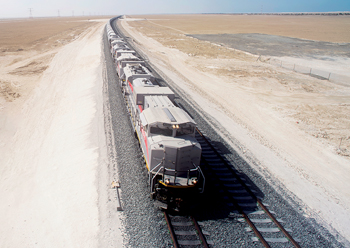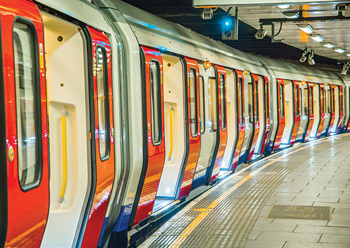
 Stage One of the UAE rail network in operation ... sleepers produced at the factory in Al Mirfa were used in its construction.
Stage One of the UAE rail network in operation ... sleepers produced at the factory in Al Mirfa were used in its construction.
Etihad Rail, the developer and operator of the UAE’s integrated railway network, has announced that its second sleeper factory is supplying locally produced components for Stage Two of the 1,200-km UAE rail network, in line with the ‘Make it in the Emirates’ strategy, which was launched recently by the UAE.
Stage Two links the UAE and Saudi Arabia from Fujairah Port to Ghuweifat through Mussafah, Khalifa Port and Jebel Ali Port. Construction work on this stage started in early 2020. Stage Two will extend 605 km from Ghuweifat on the border with Saudi Arabia to Fujairah on the east coast, to be followed by future route additions.
The second factory, located in Saih Shuaib on the border between Abu Dhabi and Dubai, covers an area of over 9,000 sq m. Having taken 12 months to build and requiring 700,000 man hours, the factory can produce 1.1 million sleepers. This facility produces 72,000 sleepers per month.
 |
|
Hogg explains the role of sleepers and how they are installed. |
Since its inception, Etihad Rail has ensured that the UAE’s national rail network is being built in accordance with world-class standards, to contribute to supporting the growth of the nation’s industrial sector and advancing the country’s wider economic growth.
Sleepers are a vital component of the railway network, as they form the base for anchoring railway tracks.
According to Etihad Rail’s Assistant Project Manager Khuloud Almazrouei, Etihad Rail took the decision to build factories to locally produce the sleepers used in the construction of the network, instead of importing them in order to boost efficiency in time, labour and cost and reduce the environmental impact of importing goods into the UAE.
She stresses that the highest quality of raw materials that are available locally, are used in manufacturing the sleepers. These factories are also contributing in creating hundreds of jobs across the UAE.
The first of the two sleeper factories was set up at Al Mirfa in the Al Dhafra region of Abu Dhabi. The 13,000-sq-m facility, able to produce 45,000 sleepers each month, manufactured all the sleepers required for Stage One of the project, according to Etihad Rail.
The 264-km Stage One of the network, delivered on schedule and within budget, has been fully operational since 2016 and is transporting granulated sulphur from sources at Shah and Habshan to the export point at Ruwais.
 |
|
Etihad Rail’s factory uses a long line method for production, comprising eight lines, with each line able to produce 400 sleepers. |
Elaborating on the sleepers and the production process, Etihad Rail’s track engineer Spencer Hogg says: “The railway sleeper is a pre-stressed concrete element that is 2.6 m long, and weighs 340 kg. Its primary function is to fix the two rails using the fastening system to maintain the gauge and the rail inclination. Its other function is to provide lateral and longitudinal stability and to transfer the load of the train through the rails to the sleeper into the ballast and to the underlying track structure. This will enable the train to safely and smoothly traverse along the tracks.”
Etihad Rail’s second sleeper factory uses a long line method for production, comprising eight lines, with each line able produce up to 400 sleepers – that is 3,200 sleepers in one casting.
“The production process includes the pre-production, which is the cleaning of the moulds, oiling of them, installing the inserts, pulling up the wires and tensioning of them. Next, we cast the concrete and vibrate it. Finally, we cure the sleepers for 12 hours using a steam curing method, and then finally, cut the sleepers and demould the next day and take to the pre-assembly area,” he says.
The sleeper factory has its own dedicated batching plant, which can produce 380 cu m a day to supply the eight production lines.
Highlighting the quality of the production, Hogg says: “All the cement and aggregates that are used in the production of sleepers are sustainably sourced from the high quality quarries in the Northern Emirates. All of the sleepers produced within the factory have to go for a detailed quality and inspection process. This ranges from dimensional checks to cube testing and bend testing on the sleepers.”
 |
|
Etihad Rail’s factory uses a long line method for production, comprising eight lines, with each line able to produce 400 sleepers. |
This includes a negative bend test where a load to 61.42 kN is held at the centre of the sleeper for three minutes. The sleeper is then checked for any cracks, before it passes the quality test. Once the sleepers have been tested and inspected, they are taken to the assembly area where the Vossloh W30HH fastening system is fixed to them ready to be loaded on the track-laying tray, he explains.
Etihad Rail was established in June 2009 to manage the development, construction and operation of the UAE’s national freight and passenger railway network. The railway network will link the principal centres of population and industry of the UAE, and will form a vital part of the planned railway network across the GCC.
Being built to international standards, the rail network will span approximately 1,200 km, acting as a catalyst for economic growth and sustained social development. Upon completion, the railway is expected to redefine logistics and transport in the region, providing a modern, safe, efficient and sustainable mode of transport that will connect all regions of the UAE to its neighbouring GCC countries.
Etihad Rail recently signed an agreement with Stevin Rock, one of the world’s largest quarrying companies based in Ras Al Khaimah, for the transport of raw materials from the northern emirate to Abu Dhabi.
 |
|
Once the sleepers have been tested and inspected, they are taken to the assembly area where the fastening system is fixed to them, ready to be loaded on the track-laying tray. |
This agreement is of considerable significance as it is a first in a series of commercial agreements for Stage Two of the UAE national rail network, which sees major organisations based in the UAE connected throughout the emirates, via Etihad Rail’s railway network, says Etihad Rail.
As per the deal, an estimated 3.5 million tonnes of construction material will be carried annually from Stevin Rock’s Al Ghail quarry in Ras Al Khaimah to Abu Dhabi, through 500 annual train trips.
Each train will measure 1 km in length, hauling 70 wagons that will have a carrying capacity of 7,000 tonnes per journey. The agreement will have significant environmental benefits, with an annual reduction of 100,000 truck trips, it adds.





















_0001.jpg)


.jpg)
















.jpg)








.jpg)




